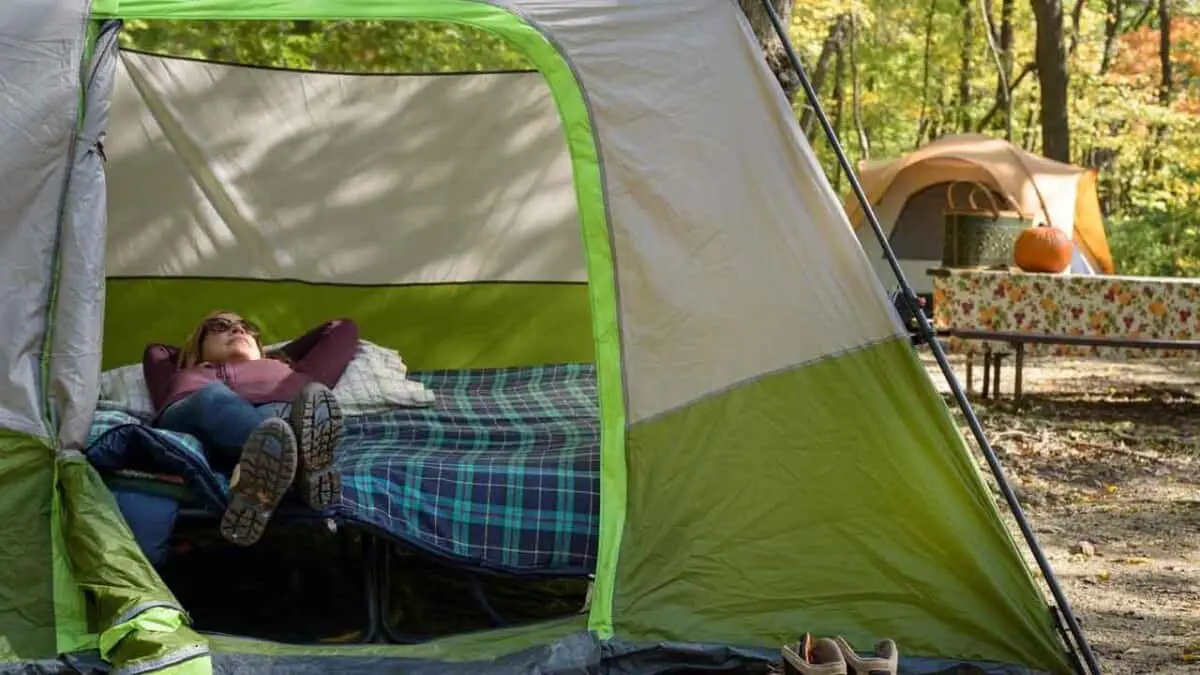Every year, you look forward to getting outside to camp. But, do you hate sleeping on the ground, a hammock, or in those uncomfortable store-bought camping cots? If so, instead of waking up with a sore back and a sour mood, why don’t you try customizing your tent cot and DIY? In this article, we’ll guide you step-by-step on how to build your very own, super comfortable DIY tent cot.
You can use several materials to construct the frame of your tent cot. However, PVC pipes will allow you to customize the size of your cot. Besides, it will also break down quickly and easily, is lightweight, and very affordable. For these reasons, PVC pipes are an excellent choice for this project.
To construct your tent cot, you will need:
- 4 three-way PVC connectors
- 4 PVC Poles
- 4 PVC pipe endcaps
- 4 two-inch long 5/8 inch carriage bolts
- 4 5/8 inch cap nuts
- 8 5/8 inch washers
- A drill with bits
- Heavy-duty outdoor fabric
- Heavy-duty sewing thread and pins
- A sewing machine
- A hacksaw or table saw
- Sandpaper
- Tape measure
- PVC cement
- Iron (optional)
Schedule 40 PVC pipe is a good choice since it’s made to withstand high water pressure and is highly durable.
If building a DIY cot is too much of a hassle for you, you can always opt to use a pre-made one. There are tons of camping cots available in the market today for every kinds of sleeper. If you’re looking to purchase one for yourself, check out our top recommendations of the best camping cots that will greatly improve your camping experience.
Four Steps to Your DIY Tent Cot
1. Determine the Size of Your Cot
Before you start, you will want to determine the size of your cot. If you are significantly larger or smaller than the average adult, you may want to take precise measurements to get an idea of the size you need. One-inch PVC pipes and connectors are usually perfect for the average adult. Meanwhile, 3/4 inch PVC is an excellent choice for kid’s cots, and anyone over 200 lbs. should use 1 1/2-2 inch pipe.
Otherwise, an easy shortcut is to base your cot size on the average twin-size air mattress. Most twin-size air mattresses are approximately 40″ wide and 80″ long. You will be able to comfortably place an air mattress on your cot or sleep without one. The choice is yours.
2. Build Your Bed Frame
To build the frame, you need to cut the PVC pipe to the correct length using your hacksaw or table saw. For example, assuming that we’re basing our cot size off an average size air mattress (40″ W x 80″ L), you can reserve a few extra inches on your cot to accommodate the air mattress if you plan to use one. In this case, we’ll assume that our cot will be 44 inches wide x 83 inches long.
You will need to cut two PVC pipes for the sides, each 83 inches long, as well as two 44 inches long pieces for the head and foot.
Making sure you’re on a stable, flat surface, you will place the pipe securely into a three-way connector with the open connector facing down. Make a mark on each connector and pipe. Then, drill a hole through the side of each connector to the inside of the frame.
Place the washers onto each carriage bolts. You will thread one washer through to the inside. Another washer will be threaded onto the bolts and topped with the cap nuts, making the frame more durable and allowing you to carry it.
3. Stand the Bed Up
Now, it’s time to stand the cot up. The height of the bed is up to you. We’ll personally make it stand 24 inches off the ground.
Using your hacksaw or table saw, cut four 24-inch-long pieces of pipe. Using the PVC cement, you can then secure the end caps onto the end of each pipe, then insert the pipe into the 3-way connector that is pointing down. Finally, for additional strength, secure added carriage bolts through each leg.
4. Sewing the Cot
When preparing your fabric, you want to leave enough added material for a sleeve to feed the PVC pipe and sew your edges. Since our cot is 44 inches wide, we’ll leave enough fabric for a 9-inch sleeve on each side.
To prepare your edges for sewing, fold over about 3/4 inches of fabric, using an iron to help with the crease. Then, fold it over again, pin down every 6 inches or so across, and sew up the edges using your sewing machine. Make sure to move the pins aside as you sew to avoid any damage to your sewing needle. You may want to double or even triple-stitch the seams for extra security.
Now comes the fun part. At this point, you can paint your bed a fun color or design a nice carrying bag for your cot. You can easily create a bag from any extra fabric used to make your cot. A carrying bag with a cinched closure or zipper is a great way to keep your cot together, so you don’t have to worry about losing any piece on your trip.
Not sure about which kind of sleeping equipment to bring for your next camping trip? We’ve got you covered! We listed the pros and cons of each kind of sleeping equipment to help you figure out which one will suit your needs. What to choose between camping cots, sleeping pads, airbeds, and hammocks? Read our article to find out.
Frequently Asked Questions (FAQs) about Building a DIY Tent Cot
What other materials can you use to construct the bed frame?
If you’re looking for an alternative to PVC piping, some camping purists opt for good old-fashioned wood to secure their bedframe. Although it’s certainly not as lightweight, it’s a more eco-friendly option and it is very sturdy.
When using wood logs, you need to make sure the logs are the appropriate size and cut to the correct length. In addition, you want to make sure they are smooth so that they won’t cause any damage to your fabric. You can do this by running over them with a knife or saw to remove any branch or bark. Then, use sandpaper to further smooth them out.
To support the cot, you can use larger, thicker logs. Cut notches into the ends of each log for the cot side pieces to rest on (source
Are there any other DIY camping projects I can do with PVC pipes?
Yes, you can take on several DIY camping projects with PVC pipes. The possibilities are endless and just a Google search away. Below are some ideas to get you started:
- A camping table (complete with paper towel holder)
- Summer camp chairs
- A teepee or play fort for the kids
- Clothes and organization racks
- A kayak roof rack/carrier for your car
- A raft
- A dog bed
- Water guns
- A kayak fishing rod rack
- A garbage bag holder
- A towel rack
- PVC cooler ice packs
All of these DIY camping projects are inexpensive and convenient additions to your family camping excursion.
What is the best material for my DIY tent cot?
When choosing your material for a cot, you want to think heavy-duty, but also want something that will be water- and extreme-weather-resistant. With that in mind, nylon and duck canvas are two great fabrics for your DIY cot.
Duck is a type of canvas. The main difference between duck canvas and regular canvas is the thread count. Duck has a higher thread count, while traditional canvas is known for its coarser weave (source
Duck is typically lighter and dries faster than a traditional canvas.
Nylon is another popular choice due to its strength, availability, price point, and quick-drying capabilities.
Conclusion
Most people assume that sleeping while camping will be uncomfortable and that could not be more wrong. There are tons of sleeping equipment available in the market today that can cater to the needs of every kind of camper. On the off chance that you still can’t find the perfect match for you, you can always build one yourself.
As long as you follow the instructions that we have provided, you’ll be able to easily build a tent cot that is perfectly tailored for your needs and preferences. Sure, making a cot from scratch requires much more effort than just buying one, but it will all be worth it once you’re lying on it and enjoying a good night’s sleep.

